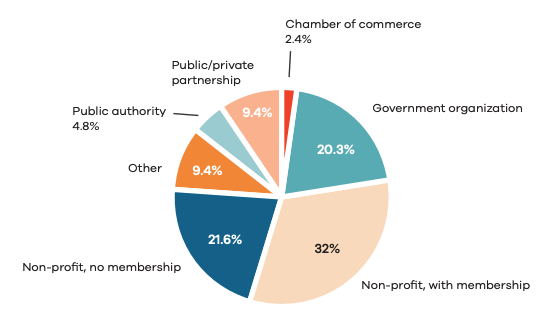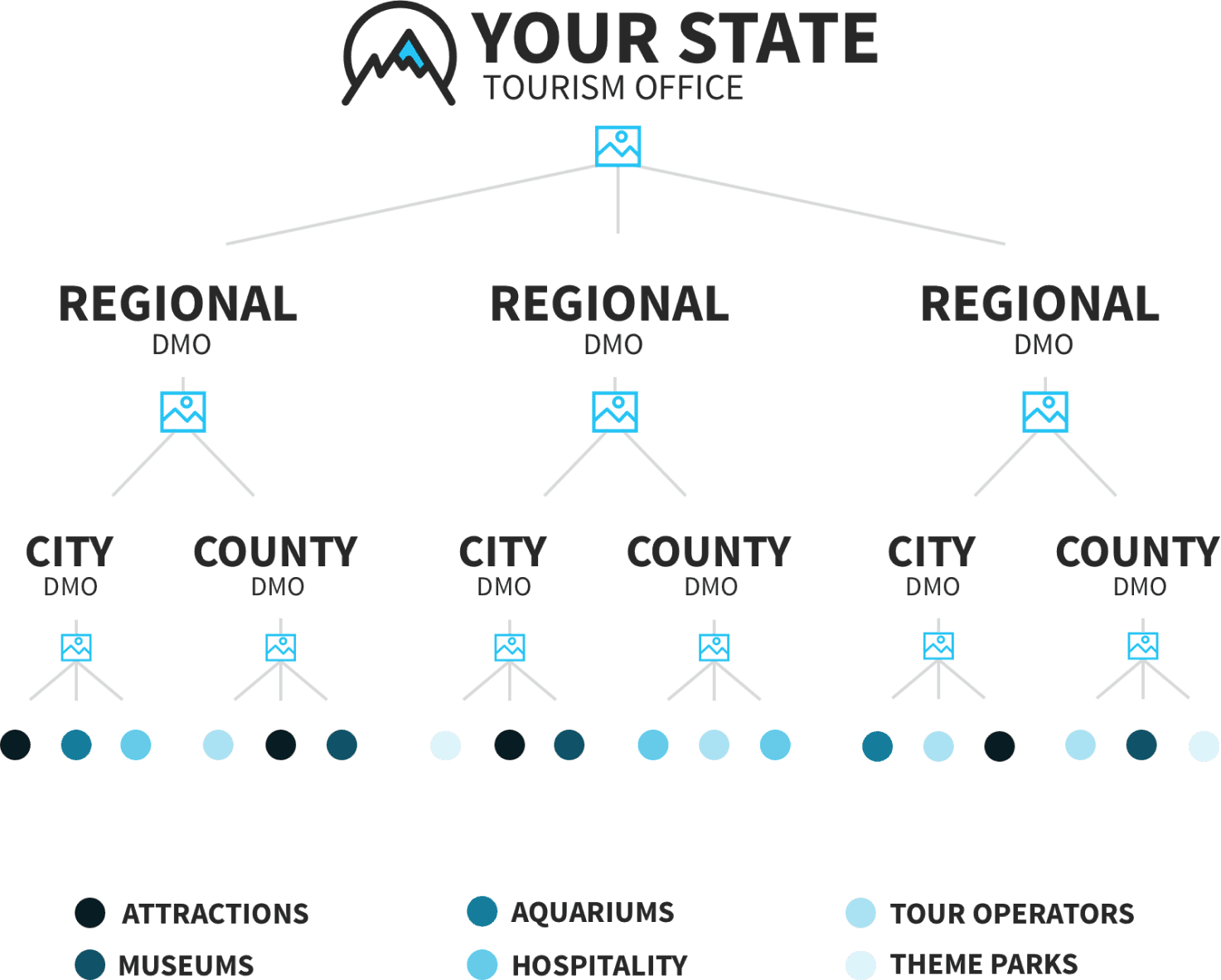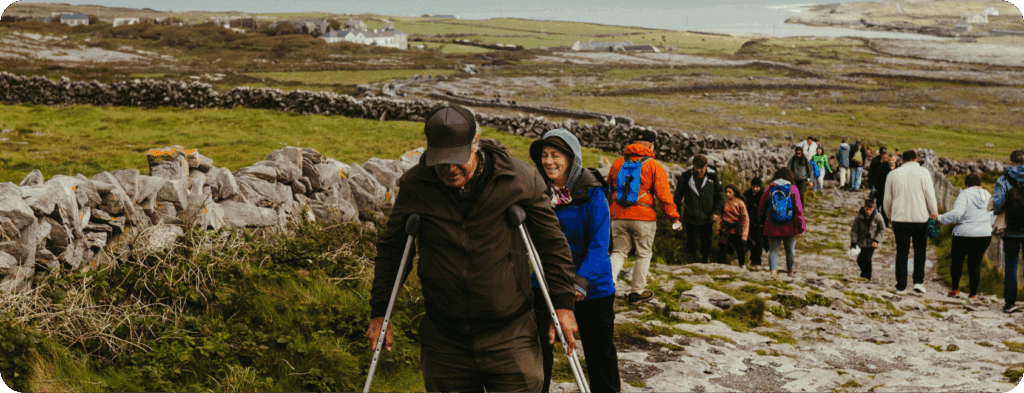
Every destination marketing organization’s (DMO) goal is to drive visitor growth and spending but there’s a wide range for how different organizations go about that, and how local tourism partners benefit.
That’s because there are a variety of DMO funding models that determine who and what an organization devotes attention to. A Destinations International DestinationNEXT 2019 survey found that about one-third of respondents (32%) were part of a non-profit with a membership model, the largest percentage of respondents.

Source: Destinations International
Nearly 22% said they had a non-profit with no membership model, while 20% were government organizations, and 9.4% had a public/private partnership.
DMOs with membership models typically focus their efforts on marketing their members, which often include tour operators, attractions, and hotels, and some funding models largely depend on the latter for tax dollars.
A Mutually Beneficial Relationship
With both travelers’ expectations and tourism arrivals increasing, it’s never been more important for DMOs and their partners to understand how to maximize their symbiotic relationship.
This relationship hinges on both DMOs and partners’ abilities to listen to each other. DMOs need to ensure that partners understand what they do and the connection between their strategies, economic impact, and partners’ business success. They also need to listen to their operators, members and other partners of all sizes to understand the challenges they face.
“The worst thing a DMO can say to an operator is ‘let me know if you need anything,’ because they don’t necessarily know what they need. Operators know that consumer behavior and marketing is changing fast,” writes William Bakker, Chief Strategist & Partner at Destination Think!.
Bakker said business owners often don’t know where to start or how to be 100% effective.
“You need to be there for them. Many DMOs conduct training sessions for their operators. They need to do more. Your operator’s marketing is a DMO’s marketing, and in an interconnected world, you need operators to maximize their efforts.”
Here are a few examples of how DMOs can sell their destination while also helping travel and tourism partners with their specific and more long term marketing plans.
1 | Create Shareworthy Content On Your Blog
Travelers love listicles and sample itineraries that are easily digestible and shareable. Some DMO blogs are widely used by locals and tourists alike and have a steady stream of organic traffic, while other tourism boards help bolster their content’s organic reach with paid media.
Visit Indy thought like travelers when it came up with the idea to write a blog post on Instagrammable foods in Indianapolis. Many travelers love to share photos of the food they eat during their trips to 1) help them remember what they ate and 2) capture moments around a dining table that everyone can relate to.
The post is a beautiful example of using multiple user-generated content (UGC) galleries to showcase delicious and photogenic Indy restaurants. Restaurant partners get some DMO spotlight treatment that comes across in an authentic way, and destination marketers have more content that highlights the unique food culture of their destinations.
Visit Huntington Beach also capitalized on travelers’ penchant for food photos when it published a blog post on local pizza place gems in the destination. After doing some keyword research, the DMO noticed there was a lot of search intent for the best local pizza joint. The result? The blog became one of their top-performing in just a few weeks.
2 | Drive Traffic to Partner Pages with CTAs
Smaller partners may not have websites or a social media presence of their own which can make DMOs’ roles even more crucial.
Yarmouth and Acadian Shores Tourism has already created 76 UGC galleries for each food and beverage partner on their website and plans to add more to help drive traffic to partners who don’t have their own social platforms.
With a team of four representing a destination with only 7,000 permanent residents, this small but mighty approach helps the tourism board make its partners relevant and the destination appears modern and accommodating.
3 | Engage In A Content Partnership
Strength in numbers is a strategy that rarely fails any organization. That’s why it’s key for the travel industry and tourism boards to form both local and regional content partnerships to amplify the stories of attractions, museums, tour operators, and hospitality partners.

Destination British Columbia took this to heart when it started using CrowdRiff’s new Travel Stories. Some 29 Destination BC partners currently participate in the network, which eliminates the need for brands to manually connect with partners to source local stories.
Since the Travel Stories pilot launched this summer, participants in the BC Localhood across the province have created over 800 stories, resulting in over 1.4 million impressions and 145,000 story views.
Even if you’re a smaller DMO or convention and visitors bureau (CVB) without access to a partner network, you can engage in content partnerships on a smaller scale.
4 | Balance Preservation with Growth
There’s a delicate balance between environmental, social, and economic development in any destination and Bhutan is a great example of how to work towards striking one and practicing destination management.
Bhutan requires travelers to spend a minimum amount per day, from $250 to almost $2000 for luxury travelers. Visitors must sign up with a registered Bhutanese tour agency before their arrival and there are also controls in place to only allow a certain amount of people into the country each day.
The government uses a portion of generated funds for social welfare programs throughout the country. Local tour operators and other Tourism Council of Bhutan partners benefit from travelers being required to use them and locals are generally happier with tourism because of its tight controls and the positive impact it has on their lives.
This is just one great example of a destination marketing organization taking progressive strides to better manage their destination so everyone wins.
Sign of The Times
If the statistic that more than half of 18 to 65-year-olds book trips purely based on images they see on Instagram, reports the Telegraph, isn’t telling of the age in which destination marketers find themselves, little else is.
DMOs ultimately aren’t responsible for partners’ sales and success, but they are in the business of telling stories that stand out to travelers and inspire them to book a trip, and that’s done best only when everyone is communicating effectively and unafraid to take risks and try new things.













